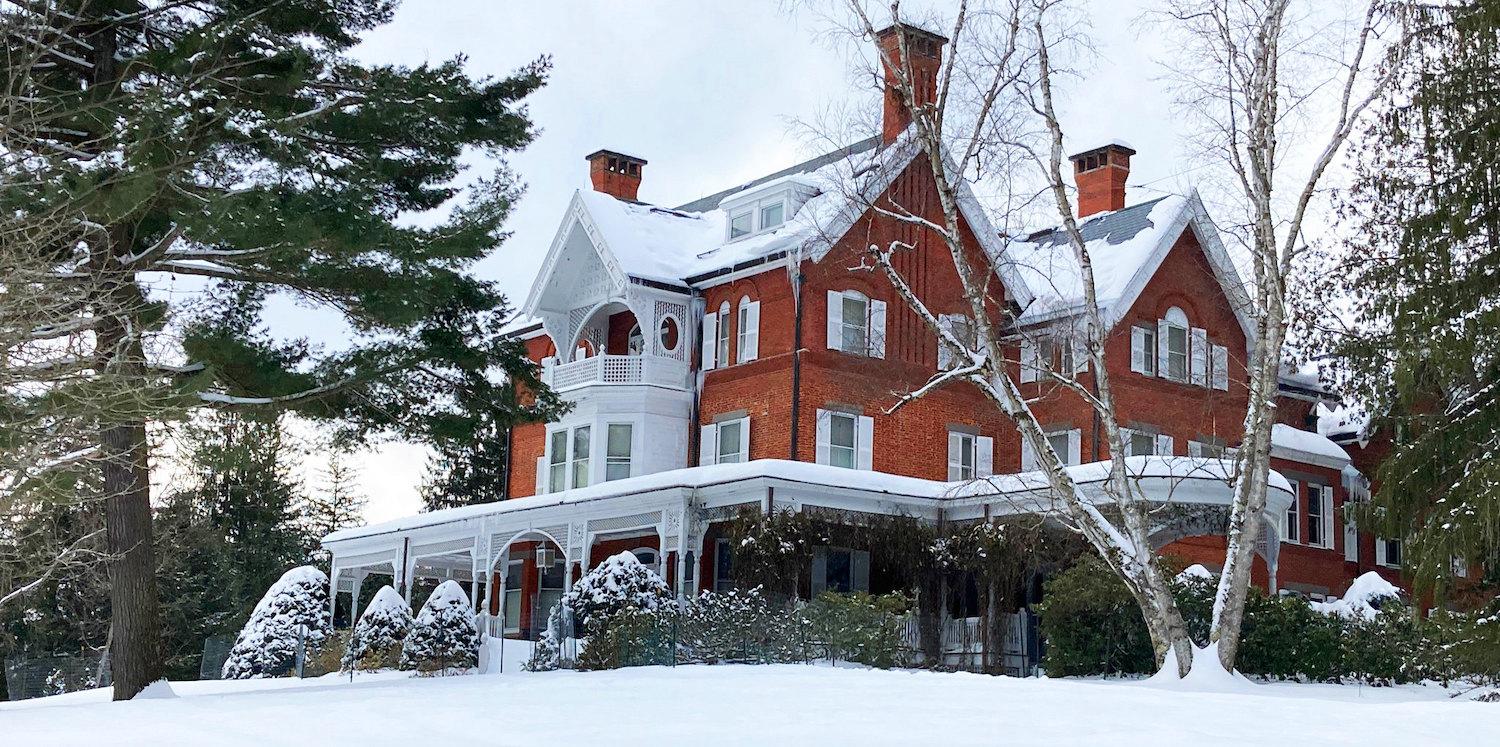 Marsh-Billings-Rockefeller National Historical Park: "An Entirely New Kind Of Park"
Marsh-Billings-Rockefeller National Historical Park: "An Entirely New Kind Of Park"
Articles By Flint Shoop
Author and professor John Elder envisioned the ideals for Vermont’s only national park at the opening of the Marsh-Billings-Rockefeller National Historical Park in 1998.
“There is a mandate to invent an entirely new kind of park. It must be one where the human stories and the natural history are intertwined; where the relatively small acreage serves as an educational resource for the entire National Park Service and a seedbed for American environmental thought; and where the legacy of American conservation and its future enter into dialogue, generating a new environmental paradigm for our day.”
A tall order no doubt, but each day the 22 to 25 permanent and seasonal staff at the park, many who split duties with Saint-Gaudens National Historical Park next door in New Hampshire, show their deep commitment to the park’s primary missions.
On the two days of my visit to the 555-acre park adjacent to the picturesque village of Woodstock, Vermont, two rangers enthusiastically shared their knowledge and dedication to four of the park's primary missions:
- To interpret the history and evolution of conservation stewardship in America;
- To recognize and interpret the birthplace and contributions of George Perkins Marsh, pioneering environmentalist, author of Man and Nature, statesman, lawyer, and linguist;
- To recognize and interpret the contributions of Frederick Billings, pioneer in reforestation and scientific farm management, lawyer, philanthropist, and railroad builder, who extended the principles of land management introduced by Marsh;
- And to recognize the significant contributions of Julia Billings, Mary Billings French, Mary French Rockefeller, and Laurance Spelman Rockefeller in perpetuating the Marsh-Billings heritage.
On the grounds, tours of the 217-year-old Victorian mansion are the featured event for visitors. Most are there to hear the well-told story of conversation by park rangers such as Jennifer Swett and Jennifer Jackson. The two engage audiences with their knowledge of the Marsh, Billings, and Rockefeller families’ time at the estate through thoughtful, informative tours ranging from A Legacy of Stewardship and Conservation Through the Artists Eye to Women of the Estate, just to name three.
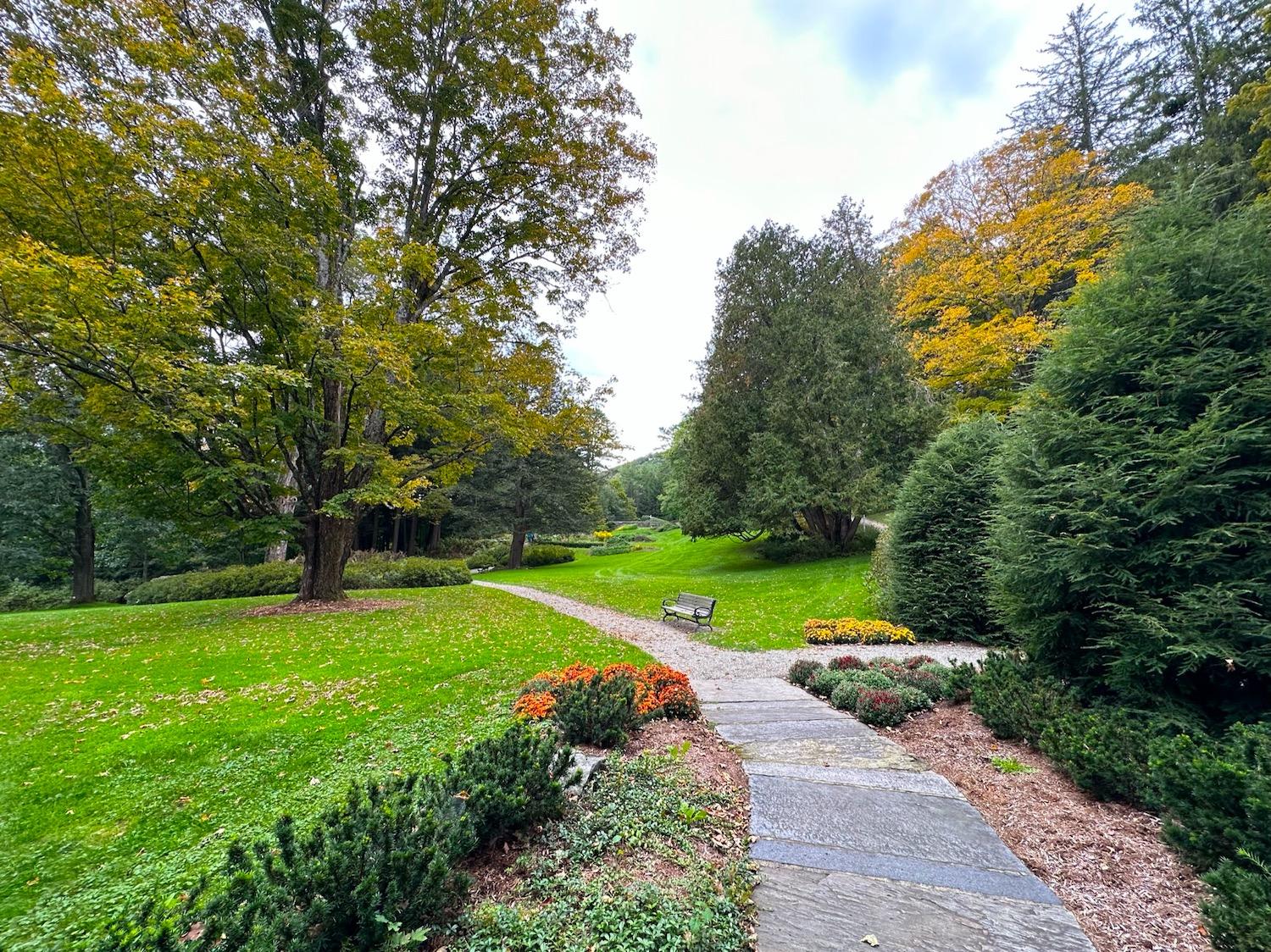
Outside of the snowy months, the well-tended grounds invite exploration/Flint Shoop
On a tour, Swett carefully relayed the importance of the eastern view from the mansion and how an opening in the Norway spruce and hemlock plantings by Frederick Billings had been cleared for a scenic view easement covering approximately 300 acres located outside the park boundaries to protect the “viewshed from the Mansion.” This easement was obtained by Laurence S. Rockefeller and then donated to the United States along with the estate donation.
But beyond the park’s original missions, Resource Management Program Manager Rainey McKenna said the park is striving to continue its many partnerships, expand their story of conservation and history, and widen the park’s story.
“Expanding the inclusiveness of our stories beyond the narratives of the three European-American families mentioned in the park’s name to include other perspectives and stewards of these lands,” she said via email. “Expanding the narrative includes expanding the park’s appeal to more diverse audiences, understanding the types of experiences new audiences are seeking for their interpretive and recreational activities, and reimagining our programming and staffing to facilitate those services and offerings.”
She noted specifically how this will move forward at the park.
“For example, the park has expanded its partnership with the Vermont Abenaki community in a variety of ways to help place the park and its history within the Abenaki traditional homeland,” she said in an email. “Park special events include Abenaki interpretive and demonstration elements, and we have initiated an Abenaki forest walk to help visitors see our primary resource through the eyes of the original inhabitants of this land, and a program that helps share Abenaki words for park flora, fauna, and features to help preserve and educate others about Abenaki language and culture.”

The Carriage Barn that serves as the park's visitor center is heated with geothermal heat/NPS
McKenna said the Park Service is using a variety of methods in efforts toward stewardship and effective resource management.
“The mansion is primarily heated with a wood-gasification boiler. This super-efficient boiler system uses wood harvested from the park’s forest,” she said. “Energy from burning the wood, and the gases produced by combustion, boils water. The hot water flows through a system of heat exchangers. The system warms the mansion through the historic radiator system, replacing the need for fuel oil.” .
One of the best examples of sustainable energy use includes the primary park headquarters located in the modified Carriage House.
“The Carriage Barn Visitor Center is heated with a geothermal system. Twelve geothermal wells were drilled into the hill in front of the Carriage Barn Visitor Center,” explained McKenna. “Long loops of pipe inside these wells circulate a fluid mixture of water and propylene glycol. The earth maintains this mixture at a constant temperature of 50°F year-round. This cool liquid helps regulate the temperature of the heat pump systems that drive the visitor center’s cooling and heating units.”
At the same time, Marsh-Billings-Rockefeller National Historic Park coordinates and cooperates with many partners including The Woodstock Foundation, Billings Farm and Museum, the Town of Woodstock, Northeast Temperate Inventory and Monitoring Network, Redstart Forestry, Shelburne Farms, as well as many community and education partners, and the public.
McKenna emphasized that the park also advances its mission through the NPS Stewardship Institute, a park-based regional program that advances stewardship study and practice in the areas of collaboration and engagement, research and evaluation, and leadership for change. The institute is a co-host of Managing by Network, “which is designed for federal managers, specialists or front-line supervisors involved in partnership and community collaboration.”
For those who value America’s national parks, the story of conservation, and the history of our nation, Marsh-Billings-Rockefeller National Historical Park must be on all serious travelers’ itineraries.
Marsh-Billings-Rockefeller National Historical Park: Maintaining History Is An Ongoing Challenge
Conservation requires cooperation, collaboration, an ability to see future needs and wants, coupled with the openness to accept constructive criticism and embrace change. But in America’s national parks, without proper funding and staffing, a gap opens between vision and reality.
Some evidence of that can be found in the rolling, leafy hills of Vermont within a national historical park tasked with tracking conservation and its evolution in America.
George Perkins Marsh prompted the mission of Marsh-Billings-Rockefeller National Historical Park nearly 160 years ago when he studiously pondered the connection between man and nature. It was a tenuous one, he wrote in Man and Nature; or, Physical Geography as Modified by Human Action, that society’s impacts on nature are not always clearly obvious.
“…our inability to assign definite values to these causes of the disturbance of natural arrangements is not a reason for ignoring the existence of such causes […] and we are never justified in assuming a force to be insignificant because its measure is unknown, or even because no physical effect can now be traced to it as its origin.”
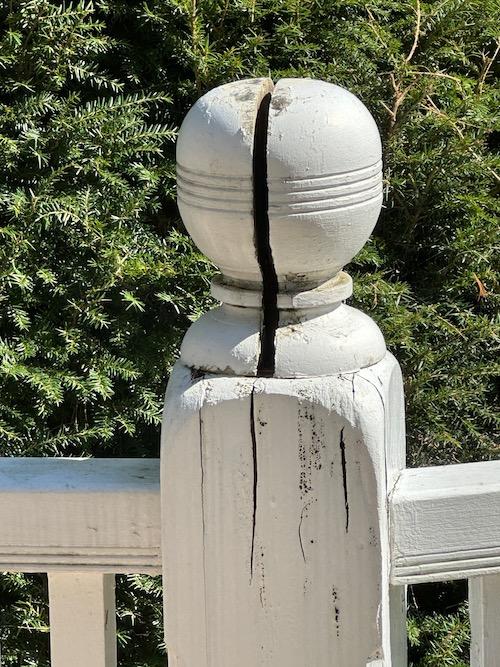
Damaging newel post cap at Marsh-Billings-Rockefeller National Historical Park/Flint Shoop
Interpreting and advancing the views of Marsh and those who followed him in environmental and conservation circles – including Frederick Billings and Laurance S. Rockefeller, whose surnames were added to Marsh’s in the park’s name, and not just because they later came to own his home – is the park’s mission.
Indeed, here in Woodstock where Marsh grew up inside the walls of a now-217-year-old Victorian mansion his father had built, the National Park Service staff tries to hew close to that mission even while many of these park professionals split duties with their sister park in New Hampshire, Saint-Gaudens National Historical Park.
But walking the park’s manicured gardens and through its hardwood forests, it becomes evident that the Park Service struggles with insufficient funding (or a will to spend their own budgets) despite recent initiatives, such as the Great American Outdoors Act that is funneling billions of dollars to the Park Service to tackle maintenance.
Despite the agency’s best efforts, it’s obvious that the park’s focal point, the namesake 1805 mansion, requires extensive exterior repair. Paint is peeling and flaking off trim and exterior ceilings, decorative newel post caps on the porch railings are split open from weather and the railings themselves are not sturdy enough to be leaned upon, downspouts are broken, and some roof areas appear damaged.
Inside the 14,000-square-foot mansion, capable staff does its best to care for a priceless, one-of-a-kind art collection, one that includes originals from the likes of Albert Bierstadt, Thomas Cole, and Grandma Moses. But it is housed in less-than-ideal conditions lacking rigorous temperature and humidity controls.
“[T]he large size of the structure and changing environmental conditions” and “winters with increased freeze-thaw cycling and wind-driven rain in summers” continually challenge the park staff and contractors, explained Rainey McKenna, the park’s resource management program manager in an email.
The conditions are not lost on the park staff.
“For the past several years there have been preservation carpentry projects ongoing at the mansion during the spring – fall construction season. There are three separate projects slated for 2023 that address needed exterior carpentry repairs on the mansion,”
But that likely will just chip away a little of the $2.86 million in deferred maintenance needs identified at Marsh-Billings-Rockefeller by the Park Service at the end of 2021. The mansion alone, with its size and age, continues to sprout needs.
There is no “blank check” to address these needs, but rather a mixture of funds that can be applied to the needs…if they’re available.

Cracks in a painting at Marsh-Billings-Rockefeller National Historical Park/Flint Shoop
The park itself has a $600,000 dedicated budget for facilities and maintenance, it can compete with other parks for additional funding from Park Service headquarters, and “Laurance and Mary Rockefeller left the park with a restricted fund, managed by the Woodstock Foundation, to provide for enhanced maintenance of the mansion and other assets,” McKenna noted.
Although Woodstock Foundation President David Simmons was unable to speak to the exact size of the Marsh Rockefeller Fund for preservation and conservation, he did say the fund was “substantial and growing.”
Simmons pointed to numerous ongoing restoration projects at the park, ranging from chimney repair to wallpaper cleaning and conservation to accessibility with safety ramps to new Eyemat Conservation Flooring - specialty “floorcoverings made up of a knitted polyester surface bonded onto a nitrile rubber backing. A rectified photographic image of the underlying historic floor is then printed onto the surface,” he explained. This addition will allow visitors to see the mansion original flooring while at the same time preserving it.
Beyond the needed structural maintenance is the one-of-a-kind art collection on display within the mansion and its need for more protective conservation.
“The fine art collection at Marsh-Billings-Rockefeller National Historical Park is one of the gems of the National Park Service. Of particular importance are the nature and landscape paintings by artists associated with the Hudson River School. The collection also includes folk art, modern art, portraits, and sculpture. There are over 500 works of art in the collection,” the Park Service states on the park website.
“Technically, 752 catalog records are classified as art, which predominantly includes drawings, engravings, paintings, prints, and sculptures. All objects that are not on display are in secure location onsite that meets NPS museum collection storage standards,” added McKenna.
But many of the pieces are more than 100 years old, with some nearing 200 years, and as McKenna noted, one the biggest needs for the park’s conservation efforts is a climate-controlled environment for the treasures. That can be a tough, and expensive, acquisition in light of a two-century-old mansion that has aging systems and a “deterioration of structural components due to age,” said McKenna.
Some of the artworks had visible cracking on the canvas, which is concerning because, according to conservators, natural resin varnishes in use by those artists can become yellowed and reduce contrast after 20 or 30 years. Today’s art conservationists can clean and revarnish such aging and greatly improve the painting’s aesthetics.
Still, some basic art conservation efforts have been put in place in the mansion. LLumar N-1065 SR CDF, a window film that reduces 99 percent of the Sun’s UV rays and is virtually invisible from either side of the glass, has been installed on more than 2,700 square feet of multi-paneled windows.
Although there is not complete agreement, generally, museum conservators agree there is a temperature and humidity range acceptable for housing fine art with temperature ranges of 60-77 degrees and relative humidity of 40 to 60 percent.
So park officials must confront the need to protect their fine art and stay true to conservation and climate efforts.
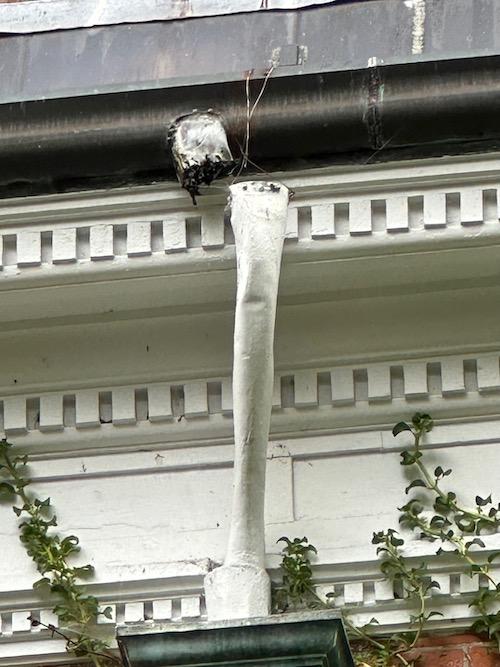
The maintenance needs of the mansion can eclipse the staff resources/Flint Shoop
But along with the need for a climate-controlled system to maintain temperatures and humidity levels to protect the artworks, there would be needed structural changes.
A climate-controlled system likely would require the physical addition of vestibules both at the mansion’s entrance and exit to accommodate the dozens of visitors touring the building each day during the season. Because of the mansion’s physical layout and the need to maintain the residence as the Marsh, Billings, and Rockefeller families used it, this would be no easy, or inexpensive, task.
How much is yet to be determined.
“The park engaged an architecture/engineering firm to provide an environmental assessment for the mansion. Through preliminary design services, the firm will assess the quality or deficiency of the existing environmental systems of the mansion with respect to impacts on collections, architectural finishes, and other historic fabric, considering the configuration and capabilities of the building envelope, existing mechanical systems, building operations, and localized climatic and air quality characteristics,” said McKenna.
“The assessment will analyze conditions of each and propose reasonable/appropriate and sustainable approaches to lessening identified adverse impacts on collections, architectural fabric, and operations.”
“The park works closely with NPS conservators based out of the national and region offices, as well as private sector conservators,” said McKenna.
Like other parks that lack subject matter experts – the Blue Ridge Parkway lacks a landscape architect, Grand Canyon National Park is without a staff geologist, and Mount Rainier National Park has no volcanologist on staff – Marsh-Billings-Rockefeller does not have an art conservator on staff who could regularly assess the condition of the artworks and aid in their interpretation.
On the grounds beyond the mansion, the Park Service is tasked with proactively managing the hardwood forest that takes up most of the acreage. Indeed, the woodlands that climb Mount Tom representative the oldest actively professionally managed forest in the United States.
Currently, two employees are responsible for managing forest conservation use the park’s 2019 Forest Management Plan in coordination “with the NPS Northeast Temperate Network Inventory and Monitoring Program, Redstart Forestry, the NPS Northeast Invasive Plant Management team, local natural resource experts, and the Abenaki community to manage to invasive species and develop an Ash Management Plan,” said McKenna.
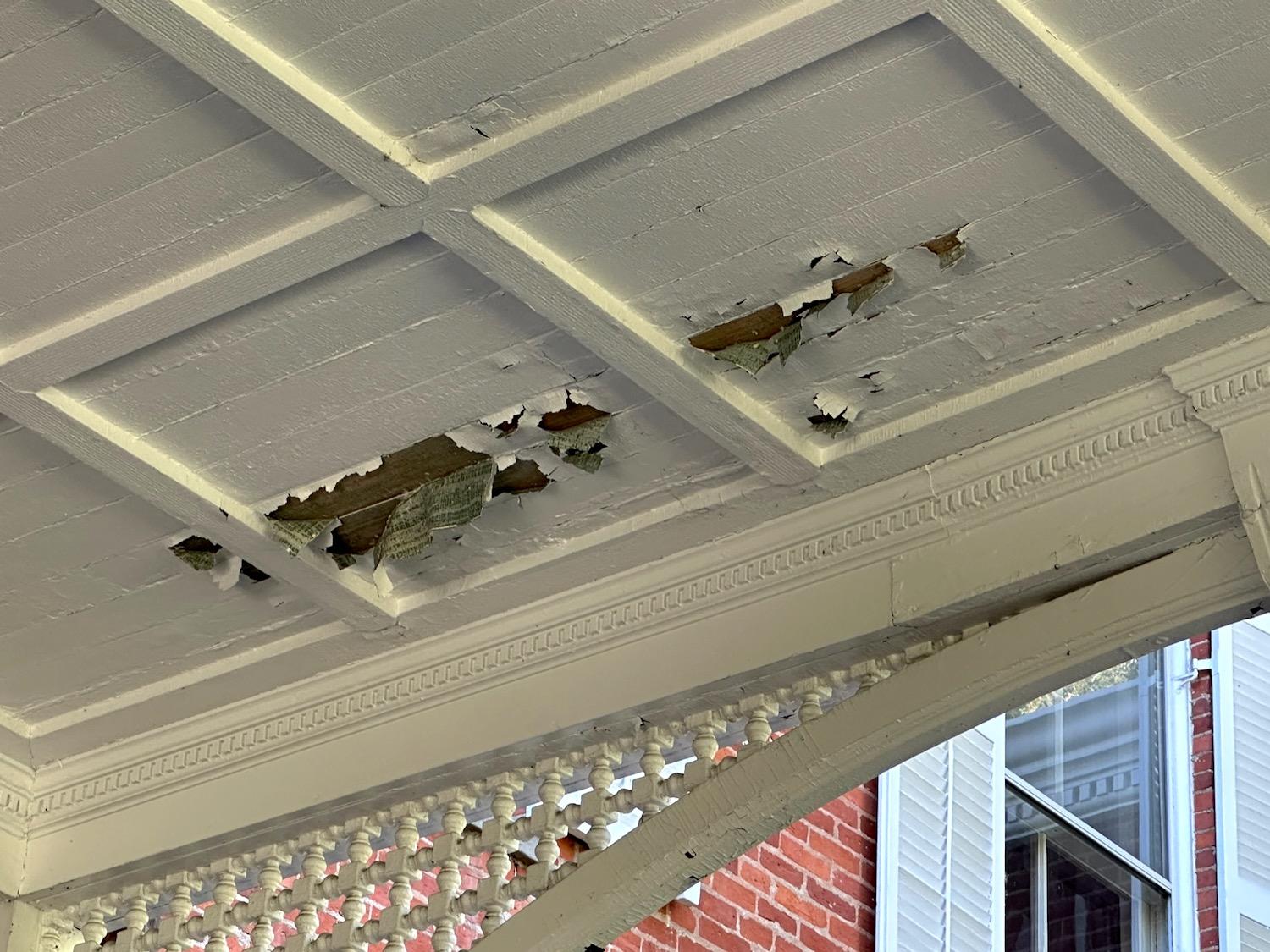
Peeling paint can be spotted around the mansion. This was spotted on the carport/Flint Shoop
Like most forestry management efforts in North America, new challenges are ever-present such as climate change and invasive species. “Our current forestry operations are focused on planning for the arrival of Emerald Ash Borer in the next 5-10 years,” said McKenna.
The park’s current and future mission goals that include a more diverse and inclusive conservation story -- “telling a more inclusive story about the history and evolution of conversation in America is something we are working towards through efforts such as consulting and working with our local Abenaki community,” noted McKenna -- are admirable and lofty.
Whether the Park Service can afford all of their mandates and newer missions, remains to be seen. But Simmons said the Woodstock Foundation through the Marsh Rockefeller Fund is “reading to evaluate and (potentially) fund projects as requested by park staff” after consultation and review.

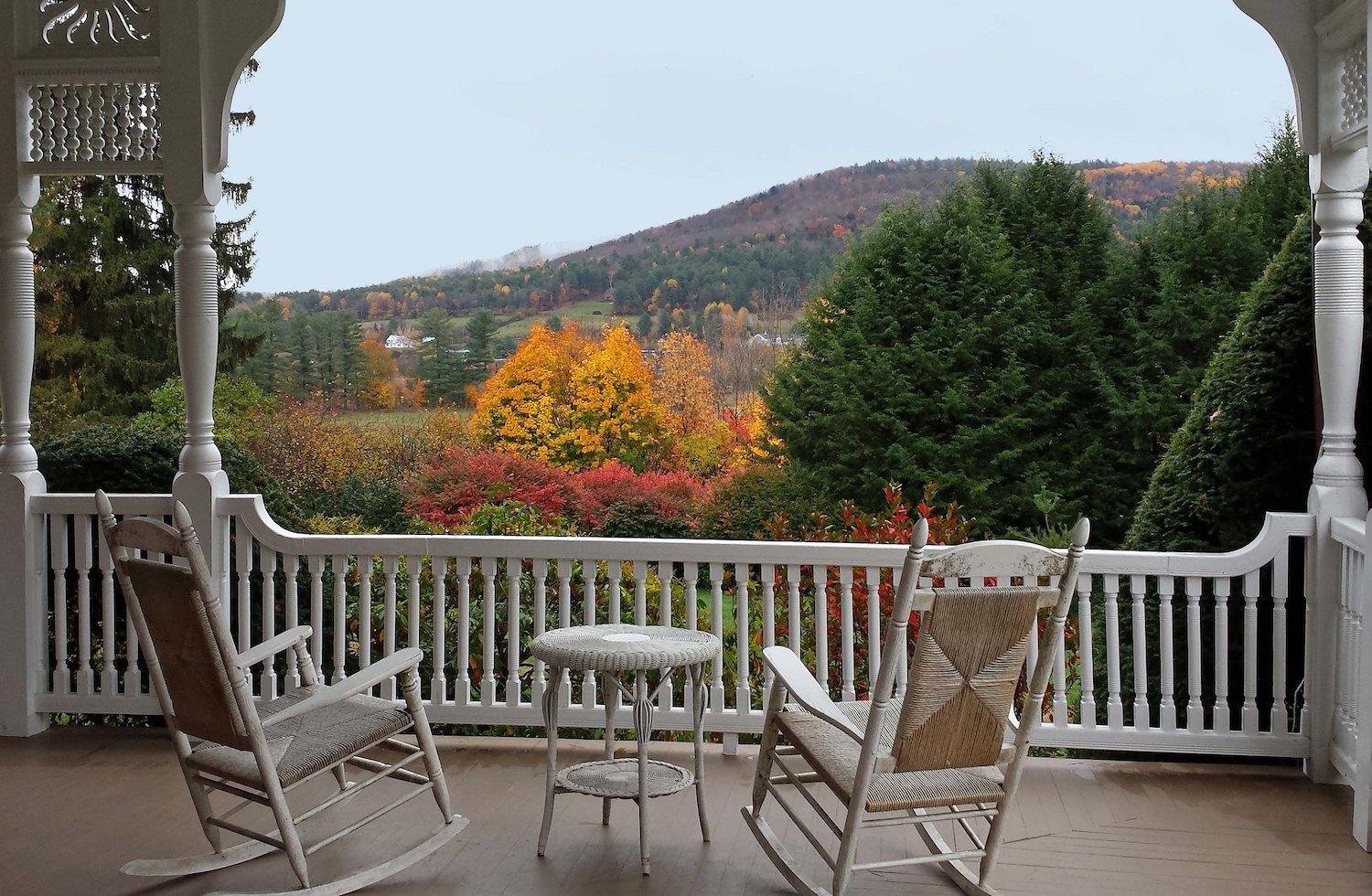

Comments
The "Vermont Abanaki" are NOT a federally recognized tribe. They are as native as someone like me who has a native in their ancestry line but are not actually descended from a line of native people. Huge difference. So much so the actual Abanaki people of Canada do not recognize the "Vermont Abanaki" as a tribe.
To quote a recognized Abanaki ""We don't want to be here fighting this," Obomsawin said. "But these fake people who are stealing our identities are getting in the way of us addressing bigger issues."
Why are federal tax dollars going to a federal park to support a tribe that is not recognized by the federal government? Who is saying these people are native? Should I apply for work? Do I qualify with my native heratige?
And how on earth can 20 people not manage one building and a garden with a wood lot? It took less than ten of us to maintain the trails in all of Yosemite Valley!
And the MAJORITY of visators NEVER actually visit the federal side of this park- which is run by a not for proft that operates as a for profit buisiness. Not saying not to go- its a cool farm. But the NPS side of the site is just a building and the backstory- that of a wealthy railroad baron whose sone read to much so they built carrage trails for him to recreate on- s not worthy of NPS resources and money. Its just not.
And if you want some actual native history in the area- visit the quechee gorge nearby- where the Abanaki did go to harvest the seasonal salmon runs. Or visit the town of South Royalton- the site of the "Royalton Raid" where natives allied with the british raided the town without warning, killing the locals, and stealing woman and children as slaves. Their is a memorial to Hannah Handy who barvely convicned the british that the children would be more hassle than it was worth and they were let go.
Actual native history in Vermont. Unlike what you will hear at Billings national monument.
I forgot the link to the article on the Abanaki fight to preserve the actual heratige of the tribe
https://vtdigger.org/2022/05/01/at-uvm-event-odanak-abenaki-question-the...
Why are federal tax dollars going to a federal park to support a tribe that is not recognized by the federal government?
Because the NPS is growing more focused on appearances, than historical fact. Sorry, that's the trend at NPS.
Yosemite closes Tamarack Flats campground almost every year for a week so that a local "tribe" (not federally recognized) can conduct a campout.
It's about appearances, not history.